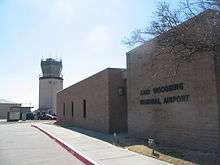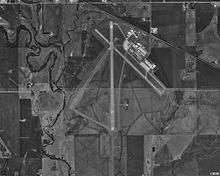Enid Woodring Regional Airport
| Enid Woodring Regional Airport | |||||||||||||||
|---|---|---|---|---|---|---|---|---|---|---|---|---|---|---|---|
 Terminal and control tower | |||||||||||||||
 USGS 1995 orthophoto | |||||||||||||||
| IATA: WDG – ICAO: KWDG – FAA LID: WDG | |||||||||||||||
| Summary | |||||||||||||||
| Airport type | Public | ||||||||||||||
| Owner | City of Enid | ||||||||||||||
| Serves | Enid, Oklahoma | ||||||||||||||
| Elevation AMSL | 1,167 ft / 356 m | ||||||||||||||
| Coordinates | 36°22′42″N 097°47′20″W / 36.37833°N 97.78889°WCoordinates: 36°22′42″N 097°47′20″W / 36.37833°N 97.78889°W | ||||||||||||||
| Website | www.enid.org/... | ||||||||||||||
| Map | |||||||||||||||
 WDG Location of airport in Oklahoma | |||||||||||||||
| Runways | |||||||||||||||
| |||||||||||||||
| Statistics (2011) | |||||||||||||||
| |||||||||||||||
Enid Woodring Regional Airport (IATA: WDG, ICAO: KWDG, FAA LID: WDG) is a city owned, public use airport located four nautical miles (5 mi, 7 km) southeast of the central business district of Enid, a city in Garfield County, Oklahoma, United States.[1] It is also referred to as Woodring Airport and was formerly known as Enid Woodring Municipal Airport. This airport is included in the National Plan of Integrated Airport Systems for 2011–2015, which categorized it as a general aviation facility.[2] It is mostly used for military training flights based at Vance Air Force Base.
Scheduled passenger flights on Great Lakes Airlines to Denver and Liberal were discontinued in August 2006. The service was subsidized by the Essential Air Service program. The airport now houses a restaurant and several rooms of aerospace and military memorabilia. Outdoors is the Woodring Wall of Honor and Veterans Park, which honors Oklahoma veterans. Ceremonies are held annually on Memorial Day to honor fallen soldiers. A two-story veterans museum at the site is in the works.[3]
History
Enid was the first city of Oklahoma to have a municipally owned airport.[4] The airport was dedicated in 1928, and built on 80 acres of land donated by a citizen backed by the American Legion, and Enid passed a $50,000 bond, making it the first city in Oklahoma to use bonds to fund an airport.[5]
I. A. Woodring
Enid's Airport was renamed Enid Woodring Municipal Airport on May 30, 1933 after Lieutenant Irvin A. (Bert) Woodring, born February 1, 1902 in Enid, Oklahoma. Irvin A. Woodring was one of the U.S. Army Air Corps' "Three Musketeers of Aviation" along with fellow pilots John J. Williams and William Lewers Cornelius.[6] The group performed aerobatics at the National Air Races. J.J. Williams died in practice at Mines Field, Los Angeles on September 11, 1928.[7] Charles Lindbergh, for whom the three had served as escorts, filled in following Williams death. Two weeks later, W. L. Cornelius died when his plane collided with another plane. On January 20, 1933, Bert Woodring fell 2,000 feet to his death over Wright Field in Dayton, Ohio, when his Consolidated P-30 fighter exploded in mid-air.
Facilities and aircraft
Enid Woodring Regional Airport covers an area of 1,206 acres (488 ha) at an elevation of 1,167 feet (356 m) above mean sea level. It has two runways: 17/35 is 6,249 by 100 feet (1,905 x 30 m) with a concrete surface; 13/31 is 3,149 by 108 feet (960 x 33 m) with an asphalt surface.[1]
For the 12-month period ending September 30, 2011, the airport had 36,000 aircraft operations, an average of 98 per day:53% military, 46% general aviation, and 2% air taxi. At that time there were 73 aircraft based at this airport: 85% single-engine, 8% multi-engine, and 7% jet.[1]
Gallery
-

Woodring Wall of Honor and Veterans Park
-

View of the restaurant
References
- 1 2 3 4 FAA Airport Master Record for WDG (Form 5010 PDF). Federal Aviation Administration. Effective April 5, 2012.
- ↑ "2011–2015 NPIAS Report, Appendix A" (PDF, 2.03 MB). National Plan of Integrated Airport Systems. Federal Aviation Administration. October 4, 2010. External link in
|work=(help) - ↑ Barron, Robert, "Woodring Wall of Honor plans to construct veterans museum", Enid News & Eagle, November 7, 2010.
- ↑ "Enid Woodring Airport: About Woodring". City of Enid, Oklahoma.
- ↑ Barron, Robert, "Enid has one of Oklahoma’s oldest municipal airports", Enid News & Eagle, February 13, 2011.
- ↑ http://www.dmairfield.com/people/woodring_ia/index.html
- ↑ http://digital.library.okstate.edu/Chronicles/v007/v007p487.html
- Essential Air Service documents (Docket OST-1997-2401) from the U.S. Department of Transportation:
- Order 2002-7-2 (July 5, 2002): selecting Air Midwest, Inc., to provide essential air service at seven communities (El Dorado/Camden, AR; Jonesboro, AR; Harrison, AR; Hot Springs, AR; Enid, OK; Ponca City, OK; Brownwood, TX) for a two-year period at subsidy rates totaling $6,693,881 annually.
- Order 2004-6-12 (June 17, 2004): requests interested persons to show cause why it should not terminate the essential air service subsidy eligibility of Jonesboro, Arkansas, Enid and Ponca City, Oklahoma, and Brownwood, Texas, and allow Air Midwest to suspend its subsidized services at those communities as of October 1, 2004, when the current rate term expires.
- Order 2005-1-14 (January 25, 2004): selecting Air Midwest, Inc., to provide essential air service at El Dorado/Camden, Jonesboro, Harrison and Hot Springs, Arkansas, at a subsidy rate of $4,155,550 annually for a two-year rate term, selecting Great Lakes Aviation, Ltd., to provide essential air service at Enid and Ponca City, Oklahoma at a subsidy rate of $1,272,557 annually for allowing Air Midwest to discontinue its service there, if it chooses to do so.
- Order 2006-7-25 (August 1, 2006): terminating the essential air service subsidy eligibility of Enid and Ponca City, Oklahoma, and allowing Great Lakes Aviation, Ltd., to suspend service at the two communities as of September 1, 2006, if it chooses.
External links
- Enid Woodring Airport at City of Enid website
- Aerial photo as of February 1995 from USGS The National Map
- FAA Airport Diagram (PDF), effective November 10, 2016
- FAA Terminal Procedures for WDG, effective November 10, 2016
- Resources for this airport:
- AirNav airport information for KWDG
- ASN accident history for WDG
- FlightAware airport information and live flight tracker
- NOAA/NWS latest weather observations
- SkyVector aeronautical chart for KWDG
- FAA current WDG delay information
- Woodring Wall of Honor and Veterans Park Official Website